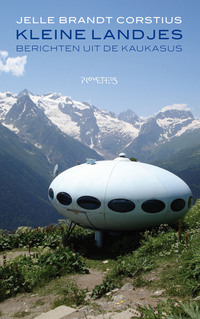29 May 2013
Book review: Kleine landjes by Jelle Brandt Corstius
 Kleine landjes — Berichten uit de Kaukasus
Kleine landjes — Berichten uit de Kaukasus
Jelle Brandt Corstius
Prometheus, Amsterdam
February 2009
170 pages
ISBN: 978-90-446-1311-7
Kleine landjes is an account of a series of trips made by the Dutch journalist Jelle Brandt Corstius, generally stationed in Moscow, to Chechnya, Kalmykia, Abkhazia, Karachay-Cherkessia and Ossetia. It is not really an introduction to the Caucasus, in fact one learns more about Russia — police corruption, bureaucracy, drinking culture — than about these republics. (Although the particular selection is original and lends credence to Corstius's professed love for small countries.)
The reasons for this are fourfold. First, Corstius intersperses his account with anecdotes from Moscow, and some of the action takes place in neighbouring Russian areas like Sochi.
Second, Corstius is not in the region to report on any dramatic events. The exception is his trip to South Ossetia shortly after the August 2008 War and his foray to some neighbouring Georgian villages, and this is indeed the most memoral part of the book.
Third, the excursions to the five republics are very short affairs, which only allow for superficial impressions and themes — hospitality, the impossibility of each of the languages and bride kidnapping. Corstius admits as much when he declares that a freelance journalist has no time to spend several days at a TBC-clinic in Abkhazia.
And fourth, Corstius's semi-naive, semi-rebellious, deadpan approach succeeds in conveying to the reader the many incongruities a western visitor is faced with, but it fails to uncover some deeper connections. For instance, when visiting a community of old-believers near Sochi, Corstius remarks that some Caucasian peoples were deported from the region in the 19th Century, without mentioning the Abkhaz — which he has just before visited (the deportations do receive a little bit more exposition when he later visits the Cherkess). In another instance, the author mentions the mysterious Obozijnen settled throughout Karachay-Cherkessia. He probably means the Abazins, which are not all that mysterious (the Abazins are closely related to the Abkhaz).
Another downside to Corstius's colourful style is that it leads to some assessments that are trite or even false, such as the assertions that time in the Caucasus has stood still since the middle ages, that pre-Soviet Russian painting was stuck in 1850 "well before impressionism", that Garri Kasparov is an evil genius because Eduard Limonov and the National Bolshevik Party are part of his broad opposition coalition and that it is no surprise that the region has seen a lot of fighting given the abundance of oil and gas — about the only time that has ever been the reason for a war in the Caucasus was probably when Hitler tried to conquer his way to Baku — and Stalingrad took the brunt of that charge.
The key observation to make is that Corstius's trips to the Caucasus were not undertaken for the purpose of writing Kleine landjes, but that the book serves as a convenient bundling of these episodes after the fact. One should read Kleine landjes then for Corstius's adventures, including a drive over the Kalmukkian steppe, his attempts to escape from his minders in Grozny and talking himself onto a fully-booked plane to Moscow due to depart within 20 minutes — especially if one enjoys his work.
Lastly, Corstius has put up a number of short videos on his website of episodes throughout the book (noted with an *), a nice little addition which helps bring to life some of the characters he encounters.